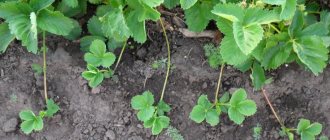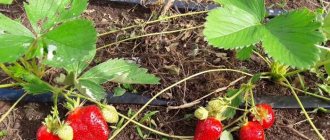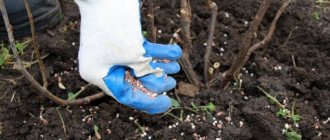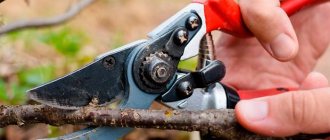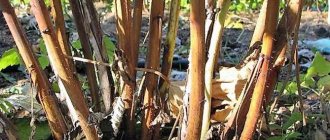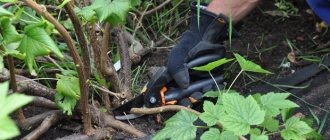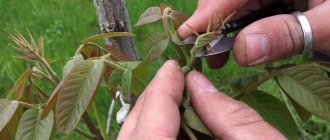Author's rating
Author of the article
Yakov Pavlovich
Professor, Head of the Department of Vegetable Growing
Articles written
153
Pruning currants in the summer after picking berries is required to maintain the bush in good condition and increase productivity in the next season. The procedure should be carried out correctly so as not to spoil the plant. It is important to take into account the timing and conditions of a particular region, which also affect when to start pruning currants. If the bush is characterized by weak growth, then it is not pruned, as this will negatively affect its condition and it will not be able to fully recover in a short time.
Why is pruning done?
Correct and timely pruning of currant bushes serves several purposes.
The procedure is necessary because it gives the following results:
- increasing the amount of nutrients supplied to the buds and shoots that will bear fruit next year;
- reducing the risk of fungal, bacterial and viral diseases;
- reducing the risk of pest infestation;
- ensuring a beautiful and correct shape of the bush, which not only looks attractive, but also provides convenience when picking berries;
- getting rid of old and weak shoots, which only take away the plant’s strength and worsen the condition before wintering;
- rejuvenation of the bush, which helps to extend its fruiting period.
The reasons for pruning are the same for all varieties of currants. If you neglect this procedure, the bushes will be weak and the yield will be significantly lower.
How to recognize diseased branches
To improve the health of a bush, sometimes you need to cut off up to several dozen unnecessary shoots. A mistake cannot be made: removing a healthy branch will weaken the plant, and just one diseased branch can destroy the entire bush. How to find out which shoots are no longer needed by the currant bush?
Also read:
Rules for pruning raspberries
- First of all, you need to cut off all the brown branches with spots of gray plaque. Young branches are covered with light, bright green bark.
- If there is practically no growth on the branch, the buds are poorly developed or absent altogether, it must be removed.
- If there are signs of disease or insect damage, remove the shoot immediately. The presence of diseases is indicated by deformation or change in foliage color (leaves curl, become stained, dry out), light or dark spots on the stem (usually at the base).
- When the bush grows excessively (in the 4th-5th year), the lower branches lie on the ground. During pruning, they must be removed, even if they are actively bearing fruit. Berries that come into contact with the ground do not ripen and quickly rot. They should not be eaten. Cut off the “lying” branches so that the currant bush does not waste energy on “empty work”.
- Remove all crooked and overly long branches. Sometimes two branches grow in parallel, closely touching each other. In this case, the weaker shoot is removed.
These rules apply to the formation of red and black currant bushes.
Leaf gall aphid
When to prune currants
There are certain times when currants are pruned. Compliance with them is mandatory, since otherwise you can cause serious harm to the bushes and, instead of increasing productivity, get the opposite effect.
By region
Pruning is carried out in spring, summer or autumn. Depending on the region in which the crop is grown, the timing of these procedures varies. Summer pruning is carried out only after harvesting. In spring, the procedure is needed only for sanitary purposes. In the summer, the main task of the gardener is to form the right bush, which can actively grow and produce high-quality harvests. In the fall, after picking the berries, the bush is also formed.
In various regions, summer pruning after harvest can be done from mid-August to mid-September. The further north the crop is grown, the earlier the manipulation is carried out. In the south, pruning can only be done in mid-September, since before that the processes occurring in the bush are too fast, and such a procedure will harm it. In the middle zone, these manipulations are carried out in the last days of August or the first of September.
According to the lunar calendar
Many gardeners pay close attention to the lunar calendar. They carry out gardening work, adhering to his recommendations regarding the timing, confident that this way the effect will be greatest. The optimal dates for pruning vary from year to year. They can occur throughout the second half of summer and early autumn. Thus, according to the lunar calendar, currant bushes can be pruned in July and August, and sometimes also in September. Which recommendations to follow—approved agricultural technology or the lunar calendar—depends on the wishes of the gardener.
Why prune shrubs?
Experts advise pruning bushes in spring or autumn. However, many experienced gardeners are convinced that pruning currants in summer is also necessary. There are two types of pruning:
- formative;
- sanitary
Formative pruning is carried out in order to form a regular rounded crown and prevent excessive branching of the bush. In the 5th year after planting, the shrub should consist of 3 four-year-old, 3 three-year-old, 4 two-year-old and 5 one-year-old branches. Timely removal of old branches provokes the growth of young fruit-bearing shoots. This event is carried out in the spring, when the bush has not yet woken up after winter, and juice transporting nutrients does not circulate in its stems.
Sanitary pruning is carried out with the aim of “cleaning” the bush of “garbage”: removing old diseased branches, cutting off all dried leaves. The plant gives them some of its strength and tries to supply nutrients. However, dried and diseased shoots will never bear fruit again. Dry branches on a currant bush are a bait for the reproduction of insect pests and fungal spores. Affecting individual parts, insects or the disease soon spreads to the entire bush.
Red and black currants are often affected by powdery mildew. This disease attacks only unkempt, overgrown bushes. The risk of a plant being damaged by powdery mildew fungal spores can be reduced by removing old “dead” branches, dry leaves and overripe unharvested crops (if any). The bush should be well ventilated and open to sunlight. The event should be held in the summer, immediately after harvest (in June or July).
Methods for forming a bush
There are several ways to form bushes during pruning, which is carried out in the summer after harvesting. Each of them pursues its own goals, and if necessary, they can be partially combined with each other. In this case, when choosing a method, you should take into account the age of the plant and the growth characteristics of a particular variety.
See also How to properly care for currants in the fall
Formative
It is carried out to give the bush the required shape, which will allow for high yields and will be convenient for collecting them. It is necessary to trim the shoots according to a certain pattern. In areas where, due to the mild climate, it is not necessary to protect plants from frost in the winter, a high trunk is formed, which prevents the berries from coming into contact with the soil, bending the branches with their weight.
The formation of the bush should begin a year after it is planted in a permanent place. In this case, only 4-5 of the strongest shoots are left on the plant. At the same time, shoots that grow inside the crown are also removed, leading to its thickening. The annual growth is trimmed, shortening it by 1/3 of the length. In this way, pruning is carried out for 2 years. As a result, in the third year a plant will be obtained with 12-15 strong skeletal branches.
Rejuvenating
For rejuvenation, pruning of the bush is carried out for black currants, starting from 4 years after planting, and for red and white - from 7-8 years. In this case, old shoots are removed, leaving strong young shoots instead. If there is little young growth, then the old shoots are cut to ½ length, and not completely removed, since the plant may not be able to withstand this.
Sanitary
In summer, sanitary pruning is not needed. This procedure is carried out only in the spring, before sap flow begins. With it, branches that died in winter, as well as damaged and diseased ones, are removed from the plant. At the same time, shoots that grow inside the crown are also removed. There will not be a large harvest on these branches, and due to their shading of the main branches and on them, the number of berries will be sharply reduced.
Advice from experienced gardeners
When growing currants, beginners encounter some difficulties, which the advice of experienced gardeners will help them cope with:
- Removing a large number of shoots is the most common mistake when pruning currants in summer. Remember that old, diseased, damaged shoots lying on the ground and annual thickening growth must be removed.
- In July and August, active sap flow begins, so after removing thick branches, treat the cuts with garden varnish.
- When pruning red and white currants, do not remove 2-3-year-old shoots: they branch well without additional pruning.
- Leave 9-12 shoots on each bush at 1-3 years of age to increase yield.
- In mid-July, feed the currant bushes with organic matter: 1 liter of mullein per 10 liters of water or 0.5 liters of bird droppings infusion per 10 liters of water. Consumption for 1 bush - 2-3 buckets.
- In order not to carry water for irrigation in buckets to the site, especially if the plantation is large, take a hose, lower it into the bucket and note how long it takes for it to become full. Multiply this time by the required number of buckets. For example, if the container is filled in 1 minute, 1 bush requires 5 buckets - accordingly, keep the hose under the plant for 5 minutes. To better absorb water into the soil, keep the pressure low.
Tools and other equipment
When pruning bushes, you must use a special tool, which must be sharp and without damage. If the pruning shears or file are dull, the plant will suffer serious damage when pruned, and the cuts will take a long time, which increases the risk of infection and also weakens the currants.
- Secateurs. Used to remove twigs up to 15 mm thick. It is better to use a two-blade tool, since it is this that gives the perfect cut.
- Lopper. Unlike pruning shears, it has longer handles, which allows you to get to even hard-to-reach areas.
- Hacksaw. Used for thick branches that cannot be removed with pruning shears. Most often required when carrying out anti-aging pruning.
- Garden var. This composition is necessary for covering wounds after pruning. If left open they can become infected.
You can also use garden shears and hedge trimmers, but they are not necessary when processing currants, unlike the https://www.youtube.com/watch?v=9YTJVhenOMU listed tools.
Rules
Each variety of currant has its own peculiarities in pruning. They should be taken into account so that the result of the procedure is maximum. The only general rules will be the need for sharp tools, their mandatory disinfection before starting work and after each bush, and adherence to pruning deadlines.
Black currant
Pruning black currants has a number of features related to the fact that they bear fruit only on young shoots, which are no more than 4 years old. Leaving old branches leads to crop loss. After the harvest is harvested, old branches that have weak young growth are removed at the root, as well as shoots from the main branches if they do not produce enough berries. Summer pruning for black currants is a mandatory procedure, without which full fruiting of the bush is impossible. Only in the summer can you determine which branches are sick or do not bear fruit well, and therefore only spring and autumn pruning is not enough.
See also Benefits and harms, planting and caring for white currants
Red Ribes
The pruning pattern for red currants is different than for black currants. The fact is that it gives maximum yield only on mature shoots for 4-5 years, after which it gradually begins to decline, so they should be replaced in 7-8 years. At this age, after harvesting, the 3 weakest skeletal branches should be cut off from the bush to open up space for the growth of new basal shoots. When they grow in sufficient numbers next season, you can get rid of a few more old branches. As a result, within 2-3 years it is possible to completely renew the plant.
White currant
The most active fruiting of white currants is observed on branches 3-4 years old. After this, the yield of the bush drops sharply. When pruning, when the harvest is harvested, it is necessary to remove three old skeletal branches at the root, and also shorten the side ones, on which the berries practically do not ripen due to lack of light. Their length is reduced by 20 cm. Young side shoots are not removed.
Characteristics and features of growing crops
Black, white and red currants are members of the gooseberry family. This perennial shrub is used by gardeners as a berry crop and ornamental.
Plants can have either a compact or spreading crown, and reach 1.5 m in height. They actively develop up to 2 years, and then growth stops and the plants begin to bear fruit. The first berries appear already in the 2nd year, but the maximum yield of the crop is achieved at the age of 5-6 years.
With good care, the red currant bush produces up to 7 kilograms of berries
Currants of all types bear fruit annually; 3-7 kg of berries can be collected from one bush. Red and white fruits ripen at the end of June, and black ones in mid-July.
Blackcurrant varieties suitable for cultivation in the Moscow region and the Urals are discussed in detail in our material.
Currants are easy to grow in any region of Russia due to their high winter hardiness. Red varieties can withstand even the harshest winters. Although the crop does not need a lot of heat, it does need sunlight. If you grow berries in the shade of fruit trees, their yield will be significantly reduced.
The culture loves moisture and fertile soil rich in minerals. You can read more about fertilizing currants in our article.
How to rejuvenate a bush and improve the harvest
Since the yield on old currant branches is significantly lower than on young ones, rejuvenating pruning when growing the crop is of primary importance. In order for the plant to regularly produce high yields, it is necessary to remove the oldest shoots annually, after all the berries have been collected. They can be identified not only by eye, but also by the fact that they have the fewest berries on them, or they are completely absent. Thanks to this procedure, young shoots will receive more space and nutrition for development, which means that next year their yield will be higher.
Pruning black current in garden
Further care after pruning
Manipulations such as pruning are a stressful situation for a currant bush. To help the crop recover after the “operation” it is necessary to feed it. Fertilizer is selected taking into account the season and age of the plant.
So after the spring procedure, currants need nitrogen. But it is better to choose a complex fertilizer, since it contains a balanced composition of important microelements for crop development. A young bush requires a little more nitrogen than a three-year-old bush.
If the work took place in the fall, then the amount of nitrogen should be minimal. Products with high levels of potassium and phosphorus are recommended. You don't have to choose chemicals. Go organic.
Errors during the procedure
Mistakes when pruning currants can significantly harm the bush. The main ones are:
- preservation of parts of diseased branches on the plant - the affected shoots should be cut out completely, since it is impossible to accurately determine the extent of their damage;
- failure to treat instruments with antiseptics - this can cause the transfer of diseases from one bush to another;
- carrying out spring pruning after the start of sap flow - this weakens the plant and leads to the loss of a large part of the harvest.
Often, gardeners also neglect the need to treat the cutting areas, which is why the bush loses juice, which negatively affects its condition.

